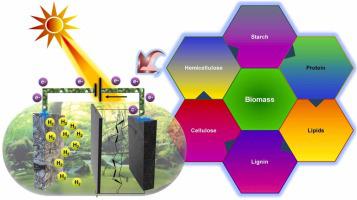当前位置:
X-MOL 学术
›
Process Saf. Environ. Prot.
›
论文详情
Our official English website, www.x-mol.net, welcomes your feedback! (Note: you will need to create a separate account there.)
Sustainable hydrogen production: Solar-powered biomass conversion explored through (Photo)electrochemical advancements
Process Safety and Environmental Protection ( IF 7.8 ) Pub Date : 2024-04-18 , DOI: 10.1016/j.psep.2024.04.068 Rajender Boddula , Yen-Yi Lee , Srinivaas Masimukku , Guo-Ping Chang-Chien , Ramyakrishna Pothu , Rajesh Kumar Srivastava , Prakash Kumar Sarangi , Manickam Selvaraj , Sanjay Basumatary , Noora Al-Qahtani
Process Safety and Environmental Protection ( IF 7.8 ) Pub Date : 2024-04-18 , DOI: 10.1016/j.psep.2024.04.068 Rajender Boddula , Yen-Yi Lee , Srinivaas Masimukku , Guo-Ping Chang-Chien , Ramyakrishna Pothu , Rajesh Kumar Srivastava , Prakash Kumar Sarangi , Manickam Selvaraj , Sanjay Basumatary , Noora Al-Qahtani

|
The incorporation of biomass waste into the process of wealth creation through the production of hydrogen, a significant fuel source for renewable energy. Hydrogen production from various biomass sources, including crop remnants, algae, or waste, makes use of easily accessible and renewable materials, ensuring an uninterrupted fuel supply without exhausting fossil fuel reserves. Traditional techniques, like gasification and pyrolysis, used for hydrogen production from biomass residues, present notable challenges such as high temperature and pressure demands, substantial capital investment, and the risk of releasing pollutants. Conversely, the innovative approach of photoelectrocatalytic biomass green hydrogen production stands at the vanguard of clean energy advancements, holding great promise for directly deriving hydrogen fuel from biomass with the help of sunlight, offering a genuinely sustainable and eco-friendly resolution. The integration of sunlight with an extra electrical stimulus for biomass-to-hydrogen conversion, leveraging resources that are abundantly available and continuously renewed, endorses the truly sustainable nature of this process. The resultant hydrogen fuel, created through this method, burns cleanly, emitting solely water vapor and thus significantly curbing greenhouse gas emissions and air pollution. This exhaustive review presents a detailed evaluation of the utilization of diverse biomass raw materials, covering carbohydrates, lignin, triglycerides (fats and oils), proteins, and terpenes for photoelectrocatalytic hydrogen production. It highlights the transformative possibilities arising from the synergistic amalgamation of electrocatalytic (EC) and photocatalytic (PC) technologies, setting the new pioneering era for a significant transition towards a sustainable and effective circular economy.
中文翻译:

可持续制氢:通过(光)电化学进步探索太阳能生物质转化
将生物质废物纳入通过生产氢气创造财富的过程,氢气是可再生能源的重要燃料来源。利用各种生物质来源(包括农作物残余物、藻类或废物)生产氢气,利用易于获取和可再生的材料,确保不间断的燃料供应,而不会耗尽化石燃料储备。用于从生物质残渣中制氢的传统技术,如气化和热解,面临着巨大的挑战,例如高温高压要求、大量的资本投资以及释放污染物的风险。相反,光电催化生物质绿色制氢的创新方法处于清洁能源进步的前沿,有望在阳光的帮助下直接从生物质中提取氢燃料,提供真正可持续和环保的解决方案。将阳光与额外的电刺激相结合,将生物质转化为氢气,利用大量可用且不断更新的资源,证实了这一过程真正的可持续性质。通过这种方法产生的氢燃料燃烧清洁,仅排放水蒸气,从而显着抑制温室气体排放和空气污染。这篇详尽的综述详细评估了各种生物质原料的利用,包括碳水化合物、木质素、甘油三酯(脂肪和油)、蛋白质和萜烯用于光电催化制氢。它强调了电催化(EC)和光催化(PC)技术协同融合所产生的变革可能性,为向可持续和有效的循环经济的重大转变奠定了新的开拓时代。
更新日期:2024-04-18
中文翻译:

可持续制氢:通过(光)电化学进步探索太阳能生物质转化
将生物质废物纳入通过生产氢气创造财富的过程,氢气是可再生能源的重要燃料来源。利用各种生物质来源(包括农作物残余物、藻类或废物)生产氢气,利用易于获取和可再生的材料,确保不间断的燃料供应,而不会耗尽化石燃料储备。用于从生物质残渣中制氢的传统技术,如气化和热解,面临着巨大的挑战,例如高温高压要求、大量的资本投资以及释放污染物的风险。相反,光电催化生物质绿色制氢的创新方法处于清洁能源进步的前沿,有望在阳光的帮助下直接从生物质中提取氢燃料,提供真正可持续和环保的解决方案。将阳光与额外的电刺激相结合,将生物质转化为氢气,利用大量可用且不断更新的资源,证实了这一过程真正的可持续性质。通过这种方法产生的氢燃料燃烧清洁,仅排放水蒸气,从而显着抑制温室气体排放和空气污染。这篇详尽的综述详细评估了各种生物质原料的利用,包括碳水化合物、木质素、甘油三酯(脂肪和油)、蛋白质和萜烯用于光电催化制氢。它强调了电催化(EC)和光催化(PC)技术协同融合所产生的变革可能性,为向可持续和有效的循环经济的重大转变奠定了新的开拓时代。



























 京公网安备 11010802027423号
京公网安备 11010802027423号